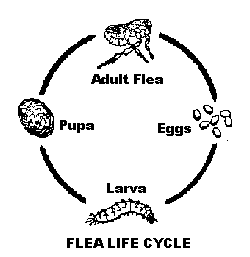Smarter Flea Control
ENTFACT-628: Pet-Centered Flea Prevention and Control | Download PDF
by Michael F. Potter, Extension Entomologist
University of Kentucky College of Agriculture

Anyone who has ever battled fleas knows how difficult they are to eradicate. Once a home becomes infested, control can be difficult, time-consuming and expensive. A flea-infested dog or cat can introduce hundreds of new flea eggs into the home each day. By mid- to late summer, pet owners often find themselves fighting a losing battle against established flea populations that are enormous.
A better way to manage fleas is through prevention. By taking action before fleas are abundant, pet owners can avoid severe infestations later in the season. Preventive flea control has been made possible by new product innovations and insights into flea biology. We now know that adult fleas (the biting stage) spend virtually their entire life on the pet, not in the carpet. Eggs are laid on the fur and fall off into carpeting, beneath furniture cushions, and wherever else the pet lays, sleeps or spends time. After hatching, the eggs transform into larvae, pupae, and eventually adults to renew the cycle.

Flea Life Cycle
Pet owners can break the cycle of flea development and prevent future generations by killing the eggs as they are laid on the pet, or by eliminating the egg-laying adults. The easiest way to do this is to take action before flea problems get out of control. Several products are available which are convenient and effective.
The “Pill” (Program™)-This product prevents flea eggs from hatching when administered orally to pets once a month at mealtime. Dogs are fed Program in tablet form, whereas cats are fed a liquid suspension mixed with their food. Different tablet sizes and suspension doses are prescribed according to the weight of the animal. When an adult female flea bites a Program-treated dog or cat, the flea ingests the active ingredient (lufenuron) which then passes into her eggs and prevents them from hatching. Program is dispensed only through veterinarians. A companion product, Sentinel™, contains both the flea control ingredient and heartworm medication all in one dosage.
“Egg-Stopper” Collars- Unlike conventional flea collars, these contain an insect growth regulating ingredient (methoprene or pyriproxyfen) which prevents egg hatch for several months. Thus, the overall effect is much like Program. Pet owners should carefully read the “active ingredients” panel on the package of the collar to verify that methoprene or pyriproxyfen are present. One such brand, the Ovitrol/Ovitrol Plus™ Flea Egg Collar is available through veterinarians. Retail versions include the Fleatrol™ Flea Egg Collar and Relieve™ Collar, sold in pet stores and discount chains. Once installed, the egg-inhibiting substance releases from the collar and rapidly distributes over the fur of the entire animal, killing flea eggs on contact. This breaks the life cycle and infestations never become established. The methoprene and pyriproxyfen-impregnated collars are virtually 100% effective at preventing new flea eggs from hatching for at least 6 months (essentially season-long) on both dogs and cats.
Spot-Ons- Another effective, convenient treatment method involves applying a few droplets of material between the shoulder blades of the animal. Two veterinarian-supplied products, Advantage™ and Frontline™, control adult fleas on pets for at least 1 month. On dogs, Frontline Top Spot lasts up to 3 months. Another ‘spot-on’ product, available through retail stores, is Biospot™, which contains the egg-inhibiting ingredient pyriproxyfen.
The best way to use any of the above-mentioned products is to initiate treatment before flea season begins, typically in the spring. By doing so you will greatly reduce the chances of developing a serious flea problem later in the summer. Any stray fleas the pet happens to pick up around the home or at the kennel will be unable to lay viable eggs. Breaking the cycle of flea development on the pet also reduces the need to apply insecticides throughout the living areas of the home. (Each of these on-animal products is of negligible hazard to people and pets, and there is seldom any adverse reaction with other petmedications.) Methoprene or pyriproxyfen-based products may need to be supplemented, periodically, with a topical spray or dip to knock down any adult fleas irritating the pet, especially if the animal is flea allergic. This should not be necessary with Advantage and Frontline. In any case, the occasional adult flea spotted on the pet will be unable to reproduce and soon will die off.
If you were frustrated by fleas last year, give this preventative approach a try. In Kentucky, the treatment regimen need not be maintained beyond November unless fleas continue to be a problem. Always read and follow label directions and the advice of your veterinarian.
For further information about fleas and eliminating infestations within the home, see ENTFACT-602, Ridding Your Home of Fleas.
Issued: 5/95
Revised 10/98
CAUTION! Pesticide recommendations in this publication are registered for use in Kentucky, USA ONLY! The use of some products may not be legal in your state or country. Please check with your local county agent or regulatory official before using any pesticide mentioned in this publication.
Of course, ALWAYS READ AND FOLLOW LABEL DIRECTIONS FOR SAFE USE OF ANY PESTICIDE!
Images: University of Kentucky Entomology., except boy and pet: Corel Photo CD
